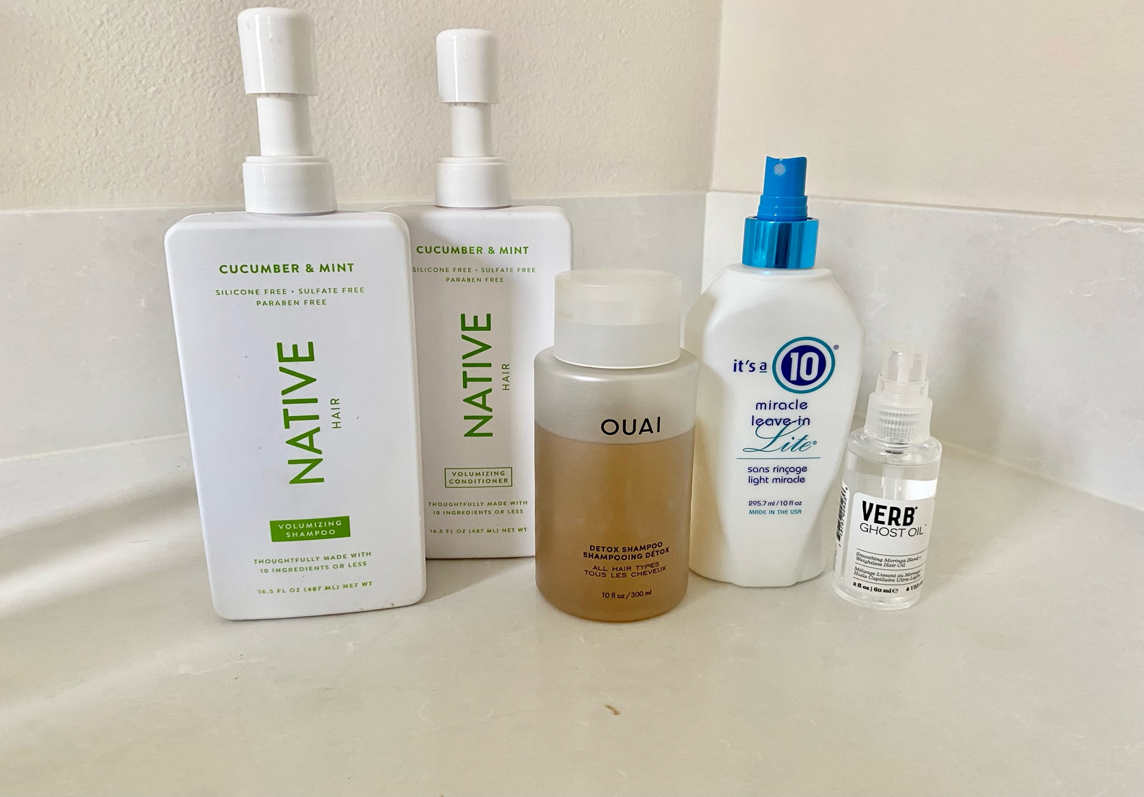Hair Routine for Fine Hair

My fine hair can be both a blessing and a curse. It’s naturally pretty soft and easy to detangle, it’s more prone to breakage than other hair types and the STRUGGLE with oiliness. But it doesn’t stop there. Figuring out how to style your hair without damage and using products that work without weighing your hair down is difficult.
I’ve written before about how to get rid of oiliness, and while anyone struggling with excessive greasiness will hopefully find that useful, this post is about how to maintain healthy fine hair. We’ll go through how to take care of your hair in the shower and how to protect you hair when styling. This is my personal routine which helps keep my hair healthy, long, and soft with moisturized ends and no breakage.
But first, how do you know if you have fine hair?
How to Identify Fine Hair
Fine hair refers to the diameter or thickness of individual hair strands, rather than the amount or density of hair on one's head. Fine hair is characterized by strands that have a smaller circumference compared to other hair types, such as medium or coarse hair.
People with fine hair often find that their hair:
- lacks volume and can appear limp and flat
- is prone to breakage and damage from heat styling tools, chemical treatments, and harsh brushing
- tends to become oily faster than other hair types due to the smaller surface area of the hair strands, which makes it easier for natural scalp oils to coat the hair

Following this routine will leave your hair feeling lightweight, soft and protected from breakage and damage. Sp where do we start?
Hair Routine for Fine Hair
1. Get a good volumizing shampoo
Volumizing shampoos are specially formulated to add body and fullness to hair, which can help fine hair look thicker and more voluminous.
These shampoos typically contain ingredients that work to coat each hair strand, creating a thicker appearance, and lifting the hair from the scalp. Some of the ingredients commonly found in volumizing shampoos include proteins, which help to strengthen hair, and polymers, which help to add volume and hold.

Volumizing shampoos can also help to remove excess oils and buildup from the scalp and hair, which can weigh hair down and make it look flat. By cleansing the hair thoroughly, volumizing shampoos can help to create a clean slate for styling and provide a better foundation for volumizing products like mousse or hairspray.
Some of my favorites:
Redken Volume Injection Shampoo
Native Volumizing Shampoo (Review)
Ouai Shampoo for Fine Hair
2. Don’t shampoo too much…or too little
How often someone with fine hair should shampoo their hair can depend on various factors, such as their hair type, scalp condition, and lifestyle. However, as a general guideline, fine-haired individuals may benefit from shampooing their hair every other day or every two to three days. I’ve found shampooing every two or three days to be the sweet spot for me.

Over-shampooing can strip the scalp and hair of natural oils, which can make fine hair appear even flatter and more limp. On the other hand, under-shampooing can lead to a buildup of oils and product residue, which can also weigh hair down and cause scalp irritation.
3. Clarify once a week
As a general guideline, people with fine hair should use clarifying shampoo once a week. It's important to pay attention to how your hair and scalp feel after using a clarifying shampoo, and adjust the frequency accordingly. If your hair feels dry or brittle after using a clarifying shampoo, it may be best to space out the usage or switch to a gentler formula.

Also, it's important to follow up with a moisturizing conditioner after using a clarifying shampoo to help restore moisture and prevent dryness. If you have color-treated hair, it's also important to choose a clarifying shampoo that is safe for color-treated hair to avoid fading or damage.
Some of my favorites:
Ouai Detox Shampoo (Read my review)
CP-1 Scalp Scaler (Read my review)
4. Don’t skip conditioner, even if your hair is oily
A few years ago a hairdresser suggested I skip conditioning my hair (the memories of this period still haunt me.) Even with fine hair, conditioner is still helpful for detangling, softening, and moisturizing your hair but it's important to choose a lightweight conditioner that won't weigh hair down. Fine hair can benefit from the moisture and nourishment that conditioners provide, but heavy or thick conditioners can make fine hair appear flat and limp.
When choosing a conditioner for fine hair, look for a formula that is labeled as lightweight, volumizing, or specifically designed for fine or thin hair. These formulas typically contain fewer oils and heavy ingredients, and more nourishing ingredients like proteins and vitamins that can help to strengthen and add volume to hair.
When applying conditioner, focus on the mid-lengths and ends of the hair, as these areas tend to be drier and more prone to damage. Avoid applying conditioner directly to the roots or scalp, as this can make hair appear greasy and oily. It's also important to rinse the conditioner thoroughly to avoid any residue that can weigh hair down.
Using a leave-in conditioner or hair oil can also be beneficial for fine hair, as these products can provide additional moisture and nourishment without weighing hair down. It's also a good idea to use a wide-tooth comb to gently detangle hair, as brushing can cause breakage and further thinning of fine hair.
Some of my favorites:
It’s a 10 Lite Leave-In
Verb Ghost Oil
5. Take advantage of heatless hairstyles to avoid frequent heat
I don’t want to avoid hot tools completely, but I try to limit my usage to 2x a week at the most. The high temperatures of hot tools can weaken the protein bonds in the hair, causing the hair to become brittle and more prone to breakage.
If you do choose to use hot tools on your fine hair, it's important to take precautions to minimize damage. This includes using a heat protectant product, using the lowest temperature possible, and limiting the amount of time that the tool is in contact with the hair.
Fine hair works really well with a lot of heat-free styling methods such as air-drying, using foam rollers, or overnight blowout kits so I love to take advantage of these for a hairstyle without any damage.
One of my favorites:
Kitsch Overnight Kit
6. When styling, use multi-purpose, lightweight products
Using lightweight products when styling is a no-brainer if you have fine hair, and I’ve written a whole article on my favorite styling products for fine hair. But it’s also important to use multi-purpose styling products. Why?

Using multi-purpose products can help to reduce the number of products you need to use on your hair, which can help to prevent buildup and make your hair care routine more efficient.
Some examples of multi-purpose hair products that can be beneficial for fine hair include volumizing sprays that gives lift and hold, leave-in conditioners that also provide heat protection, and styling products that also provide UV protection or nourishing ingredients.
Some of my favorites:
Colorwow Dreamcoat Supernatural Spray (check out some of my dupes)
Verb Dry Texture Spray
Living Proof Perfect Hair Day 5-in-1 Styling Treatment
7. Sleep on silk for less breakage
This is a tip that works for everyone, but those with fine hair and are more prone to breakage can prevent damage by sleeping on a silk pillowcase. Beyond this they also prevent moisture loss and reduce frizz. They’re also good for your skin, so they’re a win all around.

8. To scalp oil or not to scalp oil?
Scalp oiling has become popular lately as a way to treat many different scalp conditions and even assist in hair growth and reversing hair loss. While the wrong type of scalp oil can leave your scalp oilier and with more buildup, you can totally use scalp oils if you have fine hair (I even listed my favorites for fine hair here.)
A scalp oil can help to moisturize a dry, flaky scalp, which can lead to healthier hair growth. The oil can also help to stimulate blood circulation in the scalp, which can bring more nutrients to the hair follicles and promote healthier, stronger hair.
When choosing a scalp oil for fine hair, it's important to look for lightweight, non-greasy formulas that won't weigh hair down or leave it looking greasy or oily. Some oils that are beneficial for fine hair include argan oil, jojoba oil, and rosehip oil.

To use a scalp oil, start by sectioning your hair and applying the oil directly to your scalp. Massage the oil gently into your scalp with your fingertips, focusing on any areas that feel dry or flaky. Leave the oil on for at least 30 minutes or overnight, depending on the instructions on the product. Then, shampoo your hair as usual to remove any excess oil.
It's important to note that while scalp oils can be beneficial for fine hair, it's important to use them in moderation and to pay attention to how your hair responds. If your hair becomes greasy or oily after using a scalp oil, you may need to adjust the amount of oil you use or how often you use it.
My favorite:
The Ordinary Multi-Peptide Serum for Hair Density (Read my review)
Hair Routine for Fine Hair Conclusion
Having a routine for fine hair care can help to promote healthy, voluminous hair while making it easier to manage and style. It's important to choose products and techniques that are gentle and specifically designed for fine hair, and to be consistent in your hair care practices to achieve the best results.


